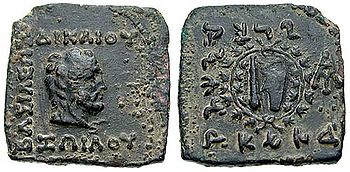
Zoilos I
Encyclopedia

India
India , officially the Republic of India , is a country in South Asia. It is the seventh-largest country by geographical area, the second-most populous country with over 1.2 billion people, and the most populous democracy in the world...
and occupied the areas of the Paropamisade and Arachosia
Arachosia
Arachosia is the Latinized form of the Greek name of an Achaemenid and Seleucid governorate in the eastern part of their respective empires, around modern-day southern Afghanistan. The Greek term "Arachosia" corresponds to the Iranian land of Harauti which was between Kandahar in Afghanistan and...
previously held by Menander I
Menander I
Menander I Soter "The Saviour" was one of the rulers of the Indo-Greek Kingdom from either 165 or 155 BC to 130 BC ....
. He may have belonged to the dynasty of Euthydemus I
Euthydemus I
Euthydemus I , Greco-Bactrian king in about 230 or 223 BCE according to Polybius., he is thought to have originally been a Satrap of Sogdiana, who overturned the dynasty of Diodotus of Bactria and became a Greco-Bactrian king. Strabo, on the other hand, correlates his accession with internal...
.
Time of reign
Zoilos used to be dated after the death of Menander, c. 130-120 BCE (Bopearachchi). Two coins of Zoilus I were however overstruck by Menander I so Zoilos came to power while Menander was still alive and was perhaps his enemy. R.C. Senior has suggested some time between 150-135 BCE.Coin types of Zoilos I
Zoilos I uses a silver coin type similar to that of Euthydemus IIEuthydemus II
Euthydemus II was a son of Demetrius I of Bactria, and became king of Bactria in the 180s BCE, either after his father's death or as a sub-king to him. The style and rare nickel alloys of his coins associates him closely in time with the king Agathocles but their precise relation remains uncertain...
, son of Demetrius
Demetrius I of Bactria
Demetrius I was a Buddhist Greco-Bactrian king . He was the son of Euthydemus and succeeded him around 200 BC, after which he conquered extensive areas in what now is eastern Iran, Afghanistan and Pakistan thus creating an Indo-Greek kingdom far from Hellenistic Greece...
: Crowned Herakles standing, holding a wreath or diadem in his right hand, and a club and the lion skin in his left hand. On some of the coins, which are of lower artistic quality, Herakles is crowned by a small Nike. Zoilos I also struck rare gold-plated silver coins with portrait and Heracles.
The Indian-standard coins of Zoilos I also bear the Pali title "Dhramikasa" ("Follower of the Dharma
Dharma
Dharma means Law or Natural Law and is a concept of central importance in Indian philosophy and religion. In the context of Hinduism, it refers to one's personal obligations, calling and duties, and a Hindu's dharma is affected by the person's age, caste, class, occupation, and gender...
"), probably related to Buddhism
Buddhism
Buddhism is a religion and philosophy encompassing a variety of traditions, beliefs and practices, largely based on teachings attributed to Siddhartha Gautama, commonly known as the Buddha . The Buddha lived and taught in the northeastern Indian subcontinent some time between the 6th and 4th...
, appearing for the first time on Indo-Greek coinage. A few monolingual Attic tetradrachms of Zoilos I have been found. Zoilos inherited (or took) several monograms from Menander I.
His bronze coins are square and original in that they combine the club of Herakles with a Scythian-type bowcase (for a short recurve bow
Recurve bow
In archery, the shape of the bow is usually taken to be the view from the side. It is the product of the complex relationship of material stresses, designed by a bowyer...
) inside a victory wreath, suggesting contacts or even an alliance with horse-mounted people originating from the steppes, possibly either the Scythians (future Indo-Scythians
Indo-Scythians
Indo-Scythians is a term used to refer to Sakas , who migrated into Bactria, Sogdiana, Arachosia, Gandhara, Kashmir, Punjab, Haryana, Uttar Pradesh, Gujarat, Maharashtra and Rajasthan, from the middle of the 2nd century BCE to the 4th century CE....
), or the Yuezhi
Yuezhi
The Yuezhi, or Rouzhi , also known as the Da Yuezhi or Da Rouzhi , were an ancient Central Asian people....
who had invaded Greco-Bactria. This bow can be contrasted to the traditional Hellenistic long bow depicted on the coins of the eastern Indo-Greek queen Agathokleia
Agathokleia
Agathokleia Theotropa was an Indo-Greek queen who ruled in parts of northern India as regent for her son Strato I.-Date and Genealogy:...
.
| Preceded by: Heliocles |
Indo-Greek Ruler (Paropamisade, Arachosia Arachosia Arachosia is the Latinized form of the Greek name of an Achaemenid and Seleucid governorate in the eastern part of their respective empires, around modern-day southern Afghanistan. The Greek term "Arachosia" corresponds to the Iranian land of Harauti which was between Kandahar in Afghanistan and... ) (130-120 BCE) |
Succeeded by: Lysias King Lysias -Time of reign:According to numismatist Bopearachchi, Lysias was a close successor to Menander I and Zoilos I, and therefore may have ruled around 130-120 BCE. R.C... |

